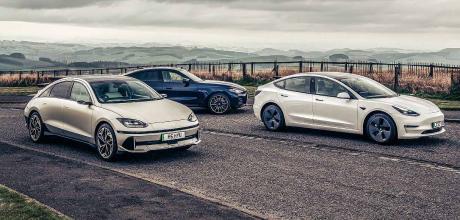2024 BMW i4 M50 G26 vs. 2023 Hyundai IONIQ 6 Ultimate 77 kWh AWD, 2023 Tesla Model 3 Dual Motor All-Wheel Drive Long Range
Giant Test: Hyundai Ioniq 6 meets the BMW i4 G26 and Tesla Model 3. Can BMW’s M division repeat its combustion success in EVs? Can Hyundai leap to the top with the Ioniq 6? Or is the Model 3 still best?
Words Ben Whitworth
Photography Olgun Kordal
When worlds collide: Tesla vs BMW vs Hyundai EV saloons
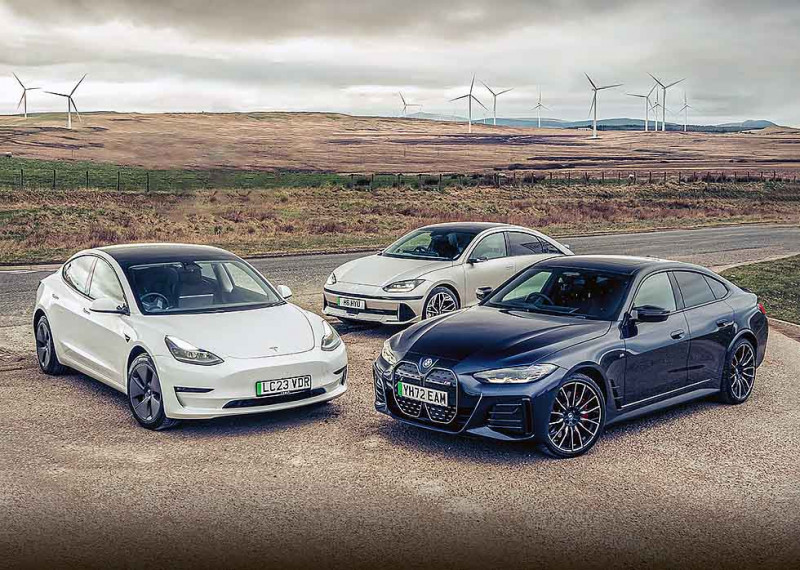
THE RULE OF 3
Radical is an overworked and undervalued word, attached to everything from wayward politicians to faddish diets. It is, however, the perfect word to describe Hyundai’s rise from peripheral player to the rock star in the nascent new world order of electric cars.
When it launched the Ioniq 5 in early 2021, the Korean colossus didn’t simply follow the Tesla playbook; it amped it up to 11 by wrapping its advanced electric architecture in one of the freshest pieces of design we’d seen in a very long time.

Equally bold models underpinned by the same platform followed from sister brands Kia and Genesis. While VW, Nissan and Ford dithered, Hyundai wrested away the electric crown and powered near-silently into the future. And now Hyundai has done it again with the Ioniq 6, a sleek four-door saloon so radically different in looks and positioning to the Ioniq 5 that it could have come from a different marque on a different continent.
As the car that fired the starter’s gun in this race to electrification, the best-selling Tesla 3 is the new Hyundai’s natural rival – also a saloon, also endowed with advanced battery and controls technology, and also likely to be on every buyer’s shortlist. And what better assessment of Europe’s battery-powered status than BMW’s first electric M car, the i4 M50? With massive firepower and driver-focused technology lurking beneath a familiar silhouette, we’re keen to see if its fresh take on the old-school saloon will create headaches for the Hyundai and Tesla.

It may have lost some of the sleek teardrop impact as it morphed from 2020 Prophecy concept to 2023 production reality, but my word the Ioniq 6 looks like a 21st-century electric car should. It’s a globule-shaped piece of the future teleported to the present, with a combination of proportion, stance and detailing that widens the eyes and slackens the jaw.
Using the same E-GMP platform, with its 800V electrical architecture, that underpins the Ioniq 5, Kia EV6 and Genesis GV60, the 6 continues both Hyundai’s expansion of its Ioniq sub-brand, and its position at the top of the design leader board.
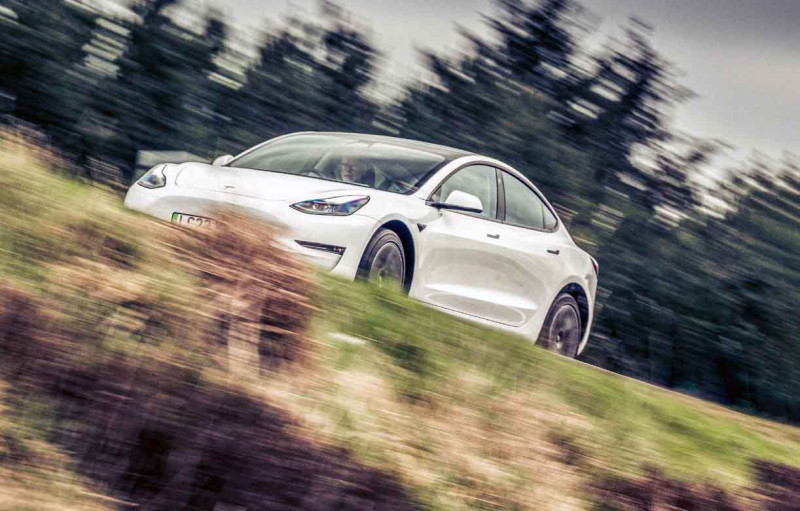
I admire its boldness and warmly welcome Hyundai’s brave decision to create something that looks nothing like its Ioniq 5 stablemate, with aerodynamics that are not just for show; it posts a drag coefficient of just 0.21. The 6 may not be everyone’s side serving of kimchi but there’s no denying it stands out. The ubiquity of the BMW’s rabid-beaver grimace has done little to diminish its aesthetic offensiveness, and the Tesla just looks blandly anonymous.
If one of Hyundai’s goals is to ignite diverse opinion on how electric cars can look, then consider the 6 firmly in the back of the net. The 6’s lounge-like cabin reinforces the message. Hyundai’s designers have taken full advantage of the spatial freedom created by the 6’s electric skateboard architecture to successfully create an intelligently configured interior that looks and feels interesting, welcoming and sumptuous in equal measure. Excellent seats, plentiful storage room, tactile materials, interesting design – the 6’s cabin makes the interior of the BMW feel oddly mundane, and takes the Tesla around the back of the design studio and gives it a double-tap to put it out of its misery. There’s a very pronounced disconnect between the way the 6 looks and the way it drives. This electric streamliner looks like it should be a wafter, a cotton-wool cruiser with a soft focus on comfort and relaxation. It feels the very opposite from behind its LED-punctuated-two-spoke wheel. Where the Ioniq 5 had a languid and laid-back approach to driver dynamics, the Ioniq 6 feels taut and keen – an altogether far more driver-orientated offering.
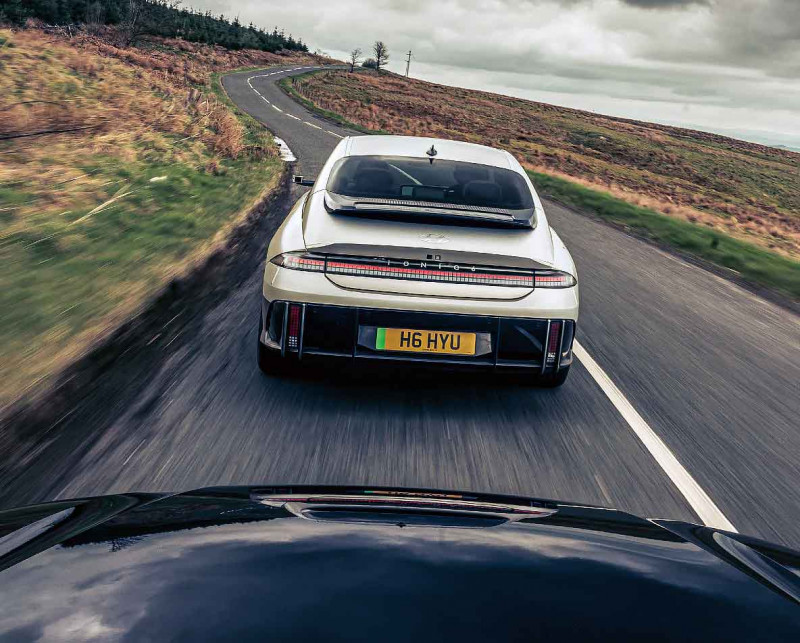
Key to this athleticism is the engaging balance between steering, powertrain, suspension, chassis and brakes. It takes no more than a few miles to appreciate the Hyundai’s dynamic polish. The direct and slack-free steering, the really well-judged level of body control, the slingshot acceleration and the responsive brakes all work coherently together to shrink-wrap what is actually a substantial and hefty car, making it feel smaller and more agile than you’d expect from first appearances. It’s best enjoyed in the surprisingly sparky Sport mode, handily accessed by the drive-mode controller on the steering wheel, calling up both front and rear motor for the full 321bhp and 446lb ft.
But it’s not all champagne and roses. On certain surfaces, at certain speeds, the Ioniq 6 feels jagged and stiff. Both the BMW and the Tesla offer a far higher overall level of comfort and compliance. Taller drivers will find themselves wishing they could sit a good three inches lower in the Hyundai, while accommodation in the rear is fine, although not being able to nudge your feet beneath the front seats is annoying.
The sheer complexity of the 6’s controls and systems, accessed through a less than intuitive menu structure, calls for a huge amount of patience and brainpower, especially when trying to silence the incessant binging and trilling that warn and inform the driver of every possible moving or stationary danger, point of interest, speed-limit sign, vehicle condition, astrological event and shift in the Dow Jones.

I appreciate that the days when it took two minutes to orientate yourself when getting out of one car and into another are long gone, and of course if you live with any car for long enough you’ll get used to it. But the interfaces of these cars illustrate their respective manufacturers’ very different approaches to the relationship between driver and vehicle. The shock of the Tesla’s radical one-screen-for-everything approach has not waned over time. After the tactile sophistication of the Ioniq 6, the 3’s cabin, with its complete lack of traditional components and anything reassuringly familiar, is quite jarring.
However, compared to the overwrought menus and displays of the Hyundai and the kitschy trying-too-hard set-up in the BMW, the Tesla’s logical and intuitive touchscreen system seems like a godsend. The driving position is better than the Hyundai’s, too – lower but still with excellent visibility.

And then I drive the Model 3 on the A68 from Jedburgh to Lauder in the Scottish Borders. This is the first Tesla I’ve piloted that didn’t feel like it was thrown together on a Friday afternoon after a three-hour liquid lunch. The Model S I drove shortly after its launch constantly creaked and groaned over every intrusion, and the Y that I drove in a recent group test felt like its springs and dampers had been swapped for lumps of concrete, with woeful handling to match.
This 3 couldn’t be more different. It feels bank-vault solid, rides and handles with a deeply appealing fluency and dynamism, and gets a real glint in its eye when tackling the twisties. I can’t quite believe it. Its performance is stonking – demonstrably quicker than the Hyundai at all speeds and capable of pushing past the BMW to show how it should be done on many of the roads on our 700-mile trek. The needle-sharp steering, great body control from the sophisticated damping, and fade-resistant brakes work in harmony so you can wring out every drop.
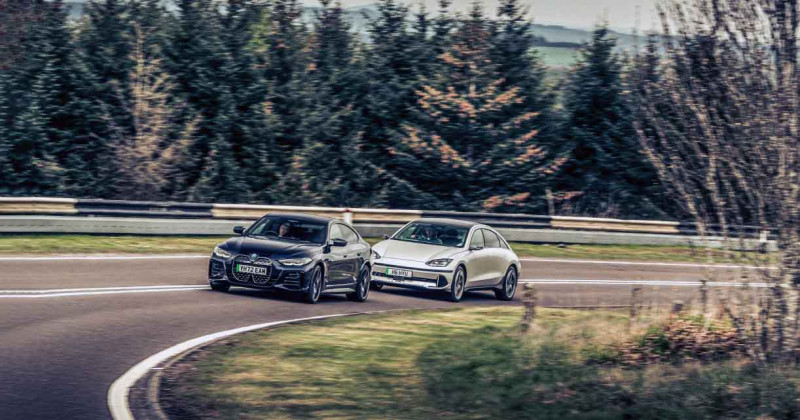
It also rides better at all speeds than its rivals. It’s not as fidgety and crashy as the Ioniq, nor is it as firm as the BMW. Like the Hyundai, cabin refinement is top-drawer. Drivetrain whine, tyre rumbles and wind rustle are eerily absent, enhancing the sense of travelling in a fast-moving hermetically-sealed capsule – strong GT vibes here. Again, night and day compared to previous Teslas I’ve tested.
All three cars feel impressively stable and planted at the high cross-country speeds they achieve, but the Tesla introduces a welcome element of agility helped largely by its ultra-quick steering and 368kg weight advantage over the BMW and 241kg over the Hyundai. Grip through corners, and traction out of them, is sensational, the 3 sweeping through the tightest of switchbacks without even popping a single bead of dynamic sweat. In short, it confounds my expectations.
If we’re talking a lot about the Tesla and Hyundai that’s because the BMW feels surprisingly ordinary in this company. That’s okay if you’re coming out of a 330e and looking for an avuncular arm around theshoulders as you take the next step on the electrification road. But it’s nowhere near okay when you remember that this is a car from BMW’s M division. Viewed through this prism, the i4 falls way short.
It rides, steers and handles just as you might expect an electric 4-series to, rather than how an M car should. That weighty and precise – if mute – steering allows you to sew the BMW from one corner to the next with pleasing accuracy. The ride quality is just the right side of firm, even on the big optional 20-inch alloys. Tackle a favourite road with enthusiasm, and you sense rather than actually feel tectonic levels of engineering and computing power jointly working overtime to keep the BMW gathered together and composed.

It seems only the BMW got the brief on how to set up the perfect driving position, with its supportive and low-slung seats, ideally positioned pedals and fully adjustable wheel. A pity, then, that the multi-screen graphics and data menus are unnecessarily glitzy, and its cabin is the noisiest. Road rumble from the big Pirelli P Zero tyres is ever-present (you can even hear it coming off the BMW when following it in the other two cars), as is the flutter and whistle of wind over the mirrors. And it’s not very efficient, often getting around 2.4 miles per kWh when the other two are topping 3.0 without even trying. As fellow tester Ben Miller notes: ‘Coming home, I left Morpeth with 140 miles to cover the 100 to Wetherby. But 20 minutes in it became clear I wasn’t going to make it unless I took drastic action, which included a long, ignominious stint on cruise pegged at 55mph, with battered old Clios flying past at 80mph. Painful.’
Instant rocket-sled performance is never more than an inch of throttle travel away, while acceleration in the hottest Sport Boost setting, which unleashes the full 537bhp and 586lb, is borderline violent. The deployment of so much torque with so little drama is comically addictive, with the i4’s incredibly sophisticated software ensuring each wheel has the micrometrically precise amount of torque at the right time. And all this is accompanied by the BMW’s Hans Zimmer-composed soundtrack – a rising cosmic wuuurping noise that you try once before permanently disabling.
Driven with intent, the BMW is quick, engaging and rewarding. But, as with the Tesla and Hyundai, pushing harder and asking for more exposes the BMW for what it is – a large and very heavy vehicle that no amount of trick variable steering, active dampers and immense computing power can fully disguise. It can often feel weighty and blunt. A claymore when you really want a foil.
FINAL RECKONING
STYLE IS NOT ENOUGH
All three of these cars come from manufacturers operating at a very high level of EV engineering excellence. Anyone worried that the loss of combusting fuel must mean duller driving need only experience one of this trio to be reassured that there’s still much to entertain, engage and inspire us. Between them they possess a wide combination of driving and ownership qualities with deep-seated sensory appeal.
The BMW i4 feels and looks rather ordinary compared to the Hyundai, and when the Tesla looms in its rear-view mirrors its dynamism and athleticism are shown to be not quite as good as they should be. Many of the i4’s key metrics around energy consumption, efficiency and charging speeds are nowhere near good enough to stand comparison with its American and Korean rivals. It’s cramped in the back, too.
This is far from a drubbing, but when you remember that we’re talking about a BMW M car you realise just how quickly the new world order can shift under electric power.
I so desperately wanted the Ioniq 6 to win this test, to swoop in with its combination of look-at-me styling and top-drawer battery technology, and set the EV bar so high that the BMW and Tesla could only stare up at it with despondent disbelief. But no. The uncomfortable low-speed ride quality; the suffocating electronics that constantly reprimand and admonish you; the barstool driving position; the clumsy user interface – the Hyundai has too many frustrating flaws and unnecessary niggles that take the shine off it. Which means the Tesla wins. All its unappealing qualities – its cheap-feeling and characterless cabin, its flair-free styling, and its white-goods ubiquity – are outweighed by its ability to glide over the most acned roads when the Hyundai stutters and stumbles, by a dynamic finesse that regularly leaves the BMW feeling flat-footed, and by the intelligence and capability of its user interface that makes the systems deployed by its rivals feel a little beta.
Factor in next-generation battery tech that magically and consistently delivers more miles per kilowatt-hour than Germany and Korea’s best, reinforced by a bespoke network that takes out much of the anxiety and apprehension around charging, and Tesla’s dominance here is as understandable as it is indisputable.
A BMW in third? A close third, but third nonetheless…
- 1st TESLA MODEL 3 Fast and agile, with access to the country’s best charging network. Excellent value, too ★★★★★
- 2nd HYUNDAI IONIQ 6 Sleek and stylish, but harsh ride and complex systems hold it back ★★★★★
- 3rd BMW i4 M50 Ballistically quick, but also a bit blunter than you want from an M car ★★★★★
Model 3 and Ioniq 6 both have boots, not hatches Ioniq the only car here that takes a big visual risk
Hyundai’s interface mixes physical and digital. Brought up on BMWs? Then the i4 will be a natural choice. Giant test: Ioniq 6 vs rivals Tesla has kept faith with its simple big screen.
THE DEPLOYMENT OF SO MUCH TORQUE WITH SO LITTLE DRAMA IS COMICALLY ADDICTIVE
i4 interface can feel complicated and cluttered
THE IONIQ 6 FEELS TAUT AND KEEN, NOT LANGUID AND LAID-BACK LIKE THE IONIQ 5
All three offer much for the keen driver. i4 and Ioniq both less than perfect dynamically
THE IONIQ 6 IS A GLOBULE-SHAPED PIECE OF THE FUTURE TELEPORTED TO THE PRESENT
It’s a Tesla, so it looks like this, for better or worse. You’ll see it before you hear it, and you won’t see it for long Ioniq loves its warnings and reprimands.
PRE-FLIGHT BRIEFING I HYUNDAI IONIQ 6
⊲Why is it here? Hyundai’s design-led EV charge takes another stylish leap forward with the Ioniq 6. It shares the same advanced E-GMP platform as the Ioniq 5, complete with 800-volt architecture for best-case 18-minute charge times, but its swoopy coupe-saloon shape looks nothing like its hatchback-SUV stablemate and shows the Korean giant is deadly serious about challenging the Europeans and Americans when it comes to upwardly mobile EV buyers.
⊲Any clever stuff? Plenty, and then some. The headline-grabbers on our test car are the optional digital side-view mirrors. They take a long while to grow accustomed to, cost £995 and they add just one mile of additional range per full charge, to put their aerodynamic benefits in context. That’s a long-term investment we couldn’t recommend.
⊲Which version is this? There are Premium and Ultimate trim levels in the UK, both pretty smart, and both with the choice of single-motor rear-drive format, or twin-motor and all-wheel drive. This is the Ultimate AWD model, with a 99bhp front and 221bhp rear motor. All UK-bound models come with 77.4kWh batteries irrespective of motor count or driven axle.
PRE-FLIGHT BRIEFING I TESLA MODEL 3
⊲Why is it here? We may think the company owner is a dangerously loose cannon, and we certainly dislike the evangelical approach many owners display, but there’s no getting away from Tesla’s current dominance of both the UK’s EV market and its charging network. Put simply, the 3 is the benchmark every credible rival must tackle. And Tesla’s recent adoption of a more budget-minded approach to pricing makes it even harder for other manufacturers to compete.
⊲Any clever stuff? Tesla’s charging technology is a great example of driver-focused thinking. Plumb your destination into the sat-nav and it will calculate if you can reach it in one stretch, and if not it will tell you to the minute how long you will need to recharge, and then it will precondition the battery en route to the station to maximise charging efficiency.
⊲Which version is this? This is the Dual Motor All-Wheel Drive in Long Range guise. It sits between the Single Motor Rear Wheel Drive model, and the bonkers Dual Motor All-Wheel Drive Performance flagship, with its blistering 3.1 seconds to 60mph and 161mph top speed. But, as ever with Tesla, be warned that it likes to change its line-up with little or no notice.
PRE-FLIGHT BRIEFING I BMW i4
⊲Why is it here? The M50 version of the i4 is the first battery-powered M car – as good a reason as any to include it in this test – but as it’s based on the 4-series Gran Coupe, it’s also a good illustration of the different EV philosophy currently adopted by BMW. Whereas the i4 looks like a regular car, because it shares some of its underpinnings with the combustion 4-series, the Hyundai and Tesla ride on bespoke EV architecture.
⊲Any clever stuff? It may not qualify as clever, but the way the i4 deploys its full-fat 537bhp and 586lb ft is seriously impressive. This colossal output isn’t available as a default – most of the time you have to make do with 476bhp and 538lb ft in Sport mode. But activate the Sport Boost mode and Ferrari-baiting muscle is all yours… in 10-second bursts. Also, in true M fashion, it has upgraded suspension, braking and steering.
⊲Which version is this? The i4 range kicks off at £49,995 with the 281bhp eDrive 35 Sport (punchy performance, rear-wheel drive) followed by the 335bhp eDrive 40 Sport, (punchier performance, still rear-wheel drive). M Sport versions of the 35 and 40 follow (extra kit, same drivetrains) and then the seriously quicker i4 M50, tested here, steps in.
AFFORDABILITY
WE SAY...
Tesla cheapest and most efficient, closely followed by Hyundai. BMW way off the pace
POWERTRAIN
WE SAY… Dual motors and all-wheel drive for these versions
PERFORMANCE
WE SAY...
All seriously quick; BMW’s acceleration is almost unhinged
BODY/CHASSIS
WE SAY...
Tesla is the lightest and feels it on the road. Hyundai’s athleticism a welcome surprise
EFFICIENCY
WE SAY...
BMW’s weight and grunt put it bottom of the list. Miserly 6 and 3 make longer trips possible
TECHNICAL DATA 2024 HYUNDAI IONIQ 6
- £55,035 (Ultimate AWD)
- Representative PCP £531 (48 payments); £8600 deposit; 10,000 miles per year; 4.9% APR Typical approved used value £44,000 (2000 miles, Premium spec)
- 77.4kWh battery, dual electric motor, single-speed transmission, all-wheel drive
- Max Power 321bhp
- Max Torque 446lb ft
- Top speed 115mph
- Acceleration 0-62mph 5.1sec
- Structure Steel
- Weight 2096kg
- Suspension MacPherson strut front, multi-link rear
- Length/width/height 4855/2073/1495mm
- Boot capacity 401 litres (+12-litre frunk)
- Official economy 4.2 miles per kWh
- Tested economy 3.4 miles per kWh
- Official range 322 miles
- Tested range 263 miles
- Emissions 0g/km CO2
TECHNICAL DATA 2023 TESLA MODEL 3
- £47,990 (Dual Motor All-Wheel Drive Long Range)
- Representative PCP £446 (48 payments); £10,000 deposit; 10,000 miles per year; 0% APR
- Typical approved used value £40,990 (11,000 miles)
- 78kWh battery, dual electric motor, single-speed transmission, all-wheel drive
- Max Power 346bhp
- Max Torque 367lb ft
- Top speed 145mph
- Acceleration 0-62mph 4.4sec
- Structure Steel
- Weight 1847kg
- Suspension Double wishbone front, multi-link rear
- Length/width/height 4964/1849/1443mm
- Boot capacity 542 litres (+88-litre frunk)
- Official economy 4.8 miles per kWh
- Tested economy 3.7 miles per kWh
- Official range 374 miles
- Tested range 289 miles
- Emissions 0g/km CO2
TECHNICAL DATA 2024 BMW i4
- £71,085 (M50)
- Representative PCP £999 (47 payments); £3285 deposit; 10,000 miles per year; 6.9% APR
- Typical approved used value £65,000 (2500 miles)
- 83.9kWh battery, dual electric motor, single-speed transmission, all-wheel drive
- Max Power 537bhp
- Max Torque 586lb ft
- Top speed 140mph
- Acceleration 0-62mph 3.9sec
- Structure Steel, aluminium
- Weight 2215kg
- Suspension Double wishbone front, multi-link rear
- Length/width/height 4783/1852/1448mm
- Boot capacity 470 litres
- Official economy 3.8 miles per kWh
- Tested economy 2.2 miles per kWh
- Official range 318 miles
- Tested range 185 miles
- Emissions 0g/km CO2


